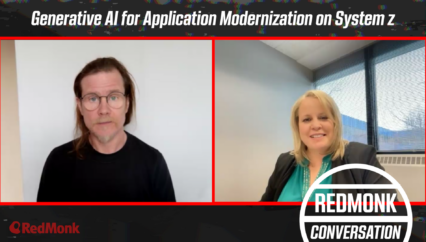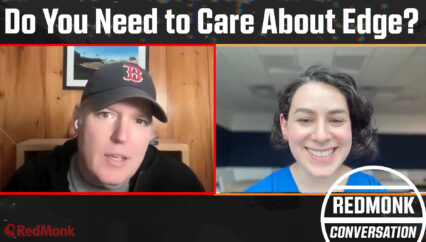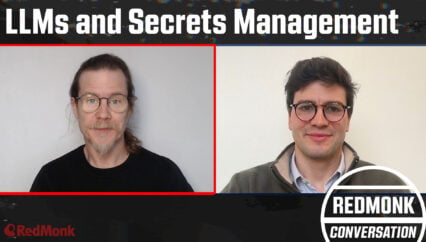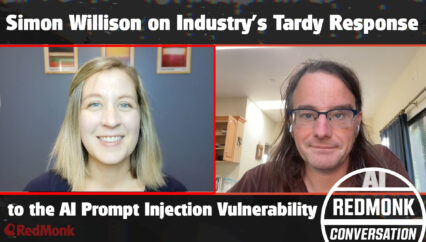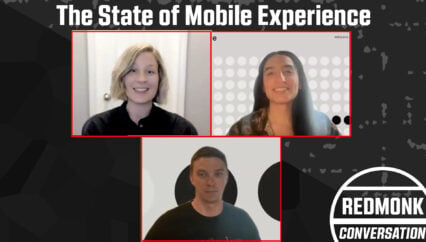Rachel Stephens, Senior Analyst at RedMonk speaks with Michael Jacobs, Sustainability & Social Innovation Leader at IBM. In this talk Mike provides an introduction to the IBM Sustainability Accelerator. Learn about how IBM partners with NGOs and governmental agencies to further water management projects.
Interested participants should visit https://www.ibm.com/impact/initiatives/ibm-sustainability-accelerator.
This was a RedMonk video, sponsored by IBM.
Rather listen to this conversation as a podcast?
Transcript
Rachel Stephens: Hi, everyone. I’m Rachel Stephens with Redmonk. And with me today is Mike Jacobs from IBM. Mike, could you do a quick introduction for us and tell us about what you’re doing at IBM?
Mike Jacobs: Of course, my name is Mike Jacobs. I lead sustainability and social innovation for IBM corporate social responsibility.
Rachel: So one of the programs within this group that we’re here to talk about today is IBM Sustainability Accelerator Program. And I thought it would be fun if I took a stab at trying to describe this endeavor, and then you can correct me if I get it wrong. So let me try to explain to the people what we’re here to talk about. So the Sustainability Accelerator is a two year program that IBM runs. It works with participants either from NGOs or governmental agencies. And these organizations come together and work with IBM to address problems that impact vulnerable populations around the world, and specifically populations that are made vulnerable from environmental problems. How’d that sound? Did I get it?
Mike: Nailed it.
Rachel: All right. So the idea then is to combine the NGO or governmental subject matter expertise for the problems at hand with some of IBM’s services and offerings and work together to accomplish shared goals. And so I think it’s a really great program in that it is trying to do social good and it’s something that I’m excited to be here today to talk about. So before we dive all the way into the upcoming session, which is what we’re here to talk about — the upcoming session is all about water management — but you’ve already run two cohorts already. So I think before we get all the way into what’s coming next, let’s take a look at what’s happened already and highlight the experience of one of your past participants, Texas A&M Agrilife.
Dr. Gurjinder S. Baath: Texas is primarily a water stressed state, and many farmers here, they use irrigation systems to fulfill their crop demands. But managing irrigation is important because we are already stressed. So a lot of research actually has been done or is still going on by Agrilife, trying to develop sustainable irrigation strategies by following which farmers can continue to produce their crops as well as they can optimize water use. So the work has been going on and based on our initial talks with IBM, we got to know the ongoing work with Liquid Prep and that’s where we realized some commonalities on the research on the irrigation management side, and that’s how actually it started and led us to join the Sustainability Accelerator.
Mike Jacobs: We as an organization strive to be a sustainable enterprise. We have a commitment to be net zero in our own greenhouse gas emissions. But our team on IBM corporate social responsibility takes an external focus to making a difference for community. We prioritize vulnerable people. So yes, we care about climate and carbon and conservation, but we care about people the most. We want to make a difference to leverage the best of IBM to help the people who are the most vulnerable to environmental threats and we’re taking a multifaceted approach, a multi issue approach to helping people where they are based on their needs on the ground.
Rachel: All right, Mike, well, before we dive into the specifics of how the program runs and operates, I wanted to focus a little bit on the high level theme of the problem space and why IBM has chosen water management for this upcoming cohorts theme.
Mike: Of course, I think it’s clear that water is an urgent issue around the world. Many of us see this day to day in our own communities. But on a global level, the gap between the global water supply and demand will reach 40% by 2030 if current practices continue. Globally, 2 billion people lack access to safely managed drinking water at home. So this is an issue of enormous scale. And then IBM looks at it and says, we have an opportunity to help. We have cutting edge technology to model and assess water conditions. We have expertise for tools that can intervene like the Internet of Things or data science. And so we are here to say we have great capabilities, we are open to partnership. And fundamentally our target is impact for the people who need help the most.
Rachel: I think that makes sense. And I think using the global lens is very helpful. So it’s not going to be a one size fits all solution, both in terms of what the problem is and how we need to address it. I think one of the other things that I would love to better understand from IBM’s perspective is how are vulnerable populations predisposed to these water challenges? I’m from Denver, and so I feel like I understand the Colorado River is in the news a lot. It’s something that’s top of mind. But I think that — that is kind of the tip of the iceberg, so to speak, for a lot of people. And so I’m curious then, if you could kind of speak to the vulnerable population aspect of this.
Mike: So vulnerability is going to vary around the world. Generally speaking, much of the global South is disproportionately facing the impact of climate change when it comes to issues like water availability. Here in the United States, people who are underserved for a variety of reasons are also seeing the legacy of underinvestment. And when it comes to water management, Flint and Newark and Jackson are just the latest examples. It’s also important to note that the landscape is changing. So many of us who have been more fortunate or have lived in communities where there is more investment, let’s say parts of Colorado, are now facing water challenges in particular around availability. And so those who are already worse off are in a situation where it’s much more dire.
Rachel: Is this a good fit for programs that have started a project and need help scaling it or help refining it? Or is this for net new projects? And then I guess the other thing is when you’re talking about IT programs, what about organizations that kind of have existing IT estates and have made investments in particular tools? Is this a partnership exclusively around IBM technology or is this something that can go broader than that?
Mike: So in terms of eligibility, it’s all of the above. And today in the accelerator, we have projects with organizations who came to us with a net new idea and were supporting solutions that an organization had already built independent of IBM, and we’re trying to optimize it for further impact. I think that speaks to the second question, which is that IBM does not need to build or use IBM Tech for this. IBM’s a hybrid cloud company these days, so we are very happy to be working and building in multiple cloud environments or across cloud environments. In addition, IBM has a long standing commitment to the open source movement, so we are very committed to showing our work, engaging other organizations, building whenever possible in a vendor agnostic type of model, and that extends onto the data as well. So sharing data, creating community models that others can contribute to — that type of approach means not just that we’ll be able, we think, to get more and better project opportunities, but also that the work is more sustainable in the longer term because more people will be able to help.
Rachel: That’s great to hear. I’m curious if you could talk a little bit about the support that a selected organization might receive. So if an NGO or government is selected to participate, what can they expect to receive from IBM and what kind of support will they get?
Mike: So number one, it’s the truly energetic and motivated commitment of the IBMers who take part. And I really can’t say enough about the excitement and the personal interest that the IBMers who have supported this already are putting to the work. The experience itself starts with the IBM garage. That’s our framework for design thinking, Agile software development. Out of that, typically in the first 3 to 4 months of the program, we’re producing what we call a technical roadmap, which is a baseline consulting style document that informs the rest of the work. From there — and the experience lasts a total of two years — IBM’s rolling up our sleeves and we’re building or supporting that technical solution. The baseline market value for all of that work is $2 million. So IBM’s making a really vested approach, taking a really vested approach to this work, and we’re committed to bringing in other partners for their expertise, for their technology and building together to better support the organization.
Rachel: That’s once people are in the program, what to expect. Can you talk to me a little bit about what to expect from the selection process itself and maybe give some feedback on — we kind of got a sense of what kind of projects are a good fit, but what is IBM looking for overall here? And kind of give us the big picture of what IBM’s success looks like here.
Mike: So our top line KPI would be the number of people who directly benefit from this work, and that can be the actual users of the technology. Those living in the community where the technology is deployed to benefit the greater good. That’s what we care about here, and that’s going to be the top criteria that we look at when we’re reviewing proposals. From there, we’re going to be reviewing the feasibility and sustainability. So is this an idea that can work? Is this something that can live on in the longer term as the organization grows out of the accelerator? Our KPIs after the social impact would be environmental impact, and that will vary across projects. But for example, the geographic size of a watershed where a solution has been deployed and technical KPIs, like the net promoter score, confirm that the solutions that we’ve built are relevant, are user friendly and are doing what they’ve set out to do.
Rachel: Well, this sounds like a really fantastic program for organizations to consider, if you are working in this space, either as an NGO or a government agency. Can you walk us through the application process and how people can get started?
Mike: Absolutely. So we’ll be accepting proposals mid-March through end of May. We are again open to proposals from nonprofit or governmental organizations that can include public universities, intergovernmental organizations and the like. We are really interested in collaborating with for profit partners to support those groups. But this is a social impact program and we want to focus on social impact organizations. Proposals can be submitted through our website and we look forward to promptly letting organizations know whether or not they’ve been selected. We expect to kick off the work in October of 2023 and for us to be working with each of those organizations for two years to follow.
Rachel: Wonderful. Well, Mike, thank you so much for taking the time to run me through the program today. And we will be sure to share any relevant links down below for those who are interested.
Mike: Thank you and thanks to everybody for the consideration. We hope to be able to work with you.
Rachel: Thanks.












